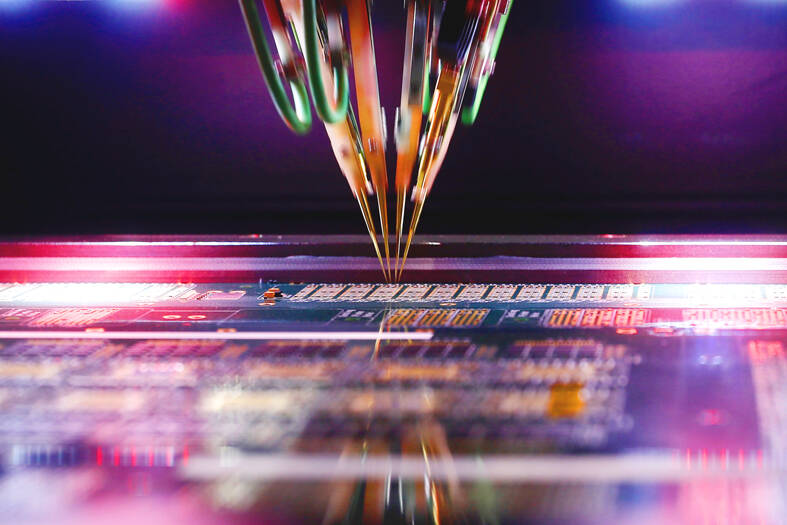Taiwan is to retain its position as the top spender on semiconductor front-end equipment and facilities next year, with spending expected to increase 4.2 percent year-on-year to US$24.9 billion, international trade group SEMI said yesterday.
The spending forecast matches an expected recovery in global semiconductor equipment and facilities investment next year, it said.
International equipment spending is to return to growth next year, SEMI said in a report, forecasting 21 percent growth to US$92 billion.

Photo: Ritchie B. Tongo, EPA-EFE
The expansion would manly be driven by robust demand for semiconductors in the automotive and high-performance computing segments, the association said.
“This quarter’s SEMI World Fab Forecast update offers our first look ahead to 2024, highlighting the steady global expansion of fab capacity to support future semiconductor industry growth driven by the automotive and computing segments and a host of emerging applications,” SEMI president and CEO Ajit Manocha said in the report.
South Korea is expected to be the second-largest spender, with investment surging 41.5 percent annually to US$21 billion next year, the report said.
China is forecast to rank third, with spending little changed from about US$16 billion this year, it said, citing the effects of US controls on exports of advanced chipmaking equipment to China.
The US is projected to retain fourth spot, with spending soaring 23.9 percent year-on-year to US$11 billion, which would be an all-time high, the report said.
Europe and the Middle East are forecast to log record investments next year, increasing spending 36 percent to US$8.2 billion, it said.
Fab equipment spending in Japan and Southeast Asia is expected to increase to US$7 billion and US$3 billion respectively, the report said.
The global semiconductor industry’s capacity is forecast to grow 5.6 percent annually next year, after an expansion of 4.8 percent this year, SEMI said.
With more suppliers providing foundry services amid increasing global capacity, the foundry segment is expected to lead the semiconductor expansion next year, with spending growing 12.4 percent annually to US$48.8 billion, it said.
This year, foundry service providers are expected to curtail their spending by 12.1 percent to US$43.4 billion, SEMI said.
Taiwan Semiconductor Manufacturing Co (TSMC, 台積電), the world’s largest foundry service provider, cut its expenditures for this year to between US$32 billion and US$36 billion from record spending of US$36.3 billion last year, citing near-term uncertainties.
TSMC said that it registered aggravated weakness in demand for chips made on 7-nanometer nodes, as PC and smartphone vendors led the tech sector in posting inventory corrections and delayed new product launches.
Memorychip makers are to significantly increase investment to US$28.2 billion next year from US$17.1 billion this year, SEMI said.
This year, memorychip makers are to slash spending 44.4 percent annually, it said.
Spending on semiconductor manufacturing equipment and facilities this year is to contract 23 percent year-on-year to US$76 billion from a record-high of US$98 billion last year, it added.

PATENTS: MediaTek Inc said it would not comment on ongoing legal cases, but does not expect the legal action by Huawei to affect its business operations Smartphone integrated chips designer MediaTek Inc (聯發科) on Friday said that a lawsuit filed by Chinese smartphone brand Huawei Technologies Co (華為) over alleged patent infringements would have little impact on its operations. In an announcement posted on the Taiwan Stock Exchange, MediaTek said that it would not comment on an ongoing legal case. However, the company said that Huawei’s legal action would have little impact on its operations. MediaTek’s statement came after China-based PRIP Research said on Thursday that Huawei filed a lawsuit with a Chinese district court claiming that MediaTek infringed on its patents. The infringement mentioned in the lawsuit likely involved

Taipei is today suspending work, classes and its US$2.4 trillion stock market as Typhoon Gaemi approaches Taiwan with strong winds and heavy rain. The nation is not conducting securities, currency or fixed income trading, statements from its stock and currency exchanges said. Authorities had yesterday issued a warning that the storm could affect people on land and canceled some ship crossings and domestic flights. Taiwan Semiconductor Manufacturing Co (TSMC, 台積電) expects its local chipmaking fabs to maintain normal production, the company said in an e-mailed statement. The main chipmaker for Apple Inc and Nvidia Corp said it has activated routine typhoon alert

GROWTH: TSMC increased its projected revenue growth for this year to more than 25 percent, citing stronger-than-expected demand for AI devices and smartphones The Taiwan Institute of Economic Research (TIER, 台灣經濟研究院) yesterday raised its forecast for Taiwan’s GDP growth this year from 3.29 percent to 3.85 percent, as exports and private investment recovered faster than it predicted three months ago. The Taipei-based think tank also expects that Taiwan would see a 8.19 percent increase in exports this year, better than the 7.55 percent it projected in April, as US technology giants spent more money on artificial intelligence (AI) infrastructure and development. “There will be more AI servers going forward, but it remains to be seen if the momentum would extend to personal computers, smartphones and

Catastrophic computer outages caused by a software update from one company have once again exposed the dangers of global technological dependence on a handful of players, experts said on Friday. A flawed update sent out by the little-known security firm CrowdStrike Holdings Inc brought airlines, TV stations and myriad other aspects of daily life to a standstill. The outages affected companies or individuals that use CrowdStrike on the Microsoft Inc’s Windows platform. When they applied the update, the incompatible software crashed computers into a frozen state known as the “blue screen of death.” “Today CrowdStrike has become a household name, but not in